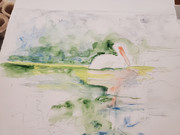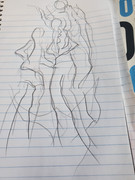Beebs52 wrote: ↑Sun Apr 06, 2025 4:13 pm
Not looking for compliments since this doesn't need one since it's sucky. This is based on a pic my nabe gave me. It is the first attempt since whenever to paint anything and is obviously not complete. Can it be redeemed? Forget the realism, mush it up? Start over. What?
Artists, raise your voices.

From a friend:
This watercolor painting has a beautiful, soft, impressionistic style. Clearly, it shows a peaceful nature scene with a white bird—most likely a pelican—resting in the water with rich green surroundings and gentle reflections.
Here’s a breakdown of what’s working and some thoughtful suggestions to complete it without losing the charm of its current form:
What’s Working
Color palette: The use of greens, blues, and soft oranges is balanced and serene—perfect for a natural wetland or riverbank.
Reflections: The reflection of the bird in the water is subtle but effective, adding depth.
Soft background wash: The loose, textured background adds atmosphere without crowding the main subject.
Impressionistic energy: The painting embraces suggestion over detail, which is perfect for watercolor.
Suggestions to Complete It
1. Finish Defining the Bird
Shape & Feathers: Use light gray and faint blue or lavender shadows to shape the belly, neck, and wing of the pelican. This adds gentle contrast while maintaining softness.
Eye & Beak Detail: A small dark dot for the eye and a more defined shape to the beak will add life and focus. A touch of darker orange or light brown can give the beak dimension.
2. Bring Out the Water’s Surface
Extend some soft horizontal strokes of color to suggest light playing on the water—maybe a few more yellows, light blues, and greens pulled from the existing palette.
Reinforce the reflection of the bird slightly with echoing color beneath it—especially a mirrored touch of orange from the beak.
3. Foreground Enhancement
Use a few quick strokes or blots of deeper green or blue-green to suggest lily pads, reeds, or subtle ripples in the foreground.
Add one or two suggested lines of water plants to lead the eye gently toward the bird.
4. Optional: Background Tree or Sky Contrast
Add a few softly defined tree silhouettes or distant foliage in the background. Stick with light gray-green or blue-green washes to preserve the dreamy look.
Final Thought
This painting has the potential to be peaceful, expressive, and elegant. It doesn’t need tight realism—just a few more confident strokes to draw the eye to the subject and suggest just enough structure.



